6 Best Phone Systems for Restaurants

However, traditional phone systems often fall short. They can miss calls, lack essential features, and struggle with multi-location support, leading to lost orders and frustrated customers.
In contrast, modern phone systems for restaurants use the internet to manage calls more efficiently. They reduce hardware setup costs and offer advanced features like call routing, auto-attendants, and voicemail transcription, helping restaurants handle calls faster, smarter, and more professionally.
In this article, we’ve rounded up the 6 best restaurant phone systems, highlighting their features, pricing, and benefits to help you find the right fit for your business.
Key Highlights:
Calilio, Nextiva, Ooma, RingCentral, 3CX, and OpenPhone are the best phone systems for restaurants, offering essential features tailored to restaurant needs.
A good restaurant communication system handles high call volumes, reduces missed calls, and wait times during busy hours.
Unlike traditional landlines, VoIP uses the internet to reduce setup costs, support remote teams, and scale easily as your restaurant grows.
Consider call volume, business hours, multi-location support, and budget when selecting the right phone system.
How Does a Restaurant Phone System Work?
A restaurant phone system manages incoming and outgoing calls to help staff communicate efficiently with customers, suppliers, and delivery services. It typically includes multiple phone lines connected to a central system, allowing calls to be routed to the right department, such as reservations, takeout orders, or management. Modern systems often feature automated answering, call forwarding, voicemail, and hold functions to handle high call volumes smoothly.
This setup ensures customers can easily place orders or ask questions without long wait times, improving overall service. Some systems also integrate with point-of-sale or reservation software, helping streamline operations and keep track of calls related to bookings or deliveries, making the restaurant’s communication more organized and efficient.
What are the Benefits of a Restaurant Phone System?
A restaurant telephone system efficiently manages customer calls, reduces waiting time, ensures no calls are missed, enhances the customer experience, and helps manage reservations and delivery efficiently.
1. Improved Call Management
A good restaurant phone system manages high call volumes efficiently and addresses all customer inquiries quickly, even during peak hours. It directs calls to the correct department, eliminating unnecessary call transfers and reducing abandoned calls.
2. Enhanced customer experience
The system routes customers to the right department or locations and reduces queue time. It also makes it easier for employees to respond to customers, enhancing the customer experience.
3. Increased Flexibility and Scalability
The multi-location support allows staff to take calls remotely and manage multiple locations through one platform. It also lets you easily add or remove users, lines, or features as your business grows without costly hardware or complicated setup, making it easy to adapt to changing needs and expand smoothly.
4. Reduces Overall Costs
A restaurant phone system reduces overall costs by automating call handling, minimizing missed orders or reservations, and reducing the need for additional staff to manage phone calls. Additionally, integrating with POS or delivery systems further helps to streamline operations and avoid manual errors.
Features to Look for in a Restaurant Phone System
When choosing a restaurant telephone system, look for advanced call routing and management, automated call analytics, and integration capabilities.
- Call routing and management: It automatically directs calls to the right department or staff to reduce wait times and improve efficiency. Interactive Voice Response (IVR), call queue, and automatic call distribution manage all incoming calls during busy hours, ensuring no missed calls.
- Voicemail and messaging: Voicemail transcription turns lengthy messages into scannable text, allowing busy staff to prioritize responses quickly. Chefs can check voicemails even when managers are not on the site.
- Call forwarding: It redirects calls to alternative numbers or devices, so no call goes unanswered.
- Call Analytics and reporting: A good restaurant communication app provides insights into call volumes, peak times, and staff performance to optimize operations.
- Call recording: Restaurants must record calls for quality control, training, and dispute resolution.
- Integration Capabilities: A good phone system for a restaurant offers integration capabilities with POS, CRM, or any reservation systems for seamless workflow.
- Auto-attendant: Look for auto-attendant features, where a virtual receptionist is always available to take customer calls even during rush hours.
- Advanced Call Queueing: In busy restaurants, too many calls at once can lead to missed calls and long wait times, frustrating customers. A smart call queuing system helps manage this by reducing delays and routing calls to the right place quickly.
- Takeout and delivery management: A phone system with features like caller ID for incoming orders, online order integration, and real-time tracking can help streamline the takeout and delivery process.
Streamline Restaurant Orders & Delivery Management With An Affordable Yet Feature-rich Cloud Phone!
Top 6 Restaurant Phone Systems in 2025
Calilio, Nextiva, Ooma, RingCentral, 3CX, and OpenPhone are among the best restaurant phone systems in 2025. These platforms offer essential and advanced call management features that help busy restaurants manage communications effectively.
1. Calilio
Calilio provides a top restaurant phone system built for busy restaurant operations. With advanced call routing and management, it handles high volumes of incoming calls during rush hours, ensuring no customer is missed.
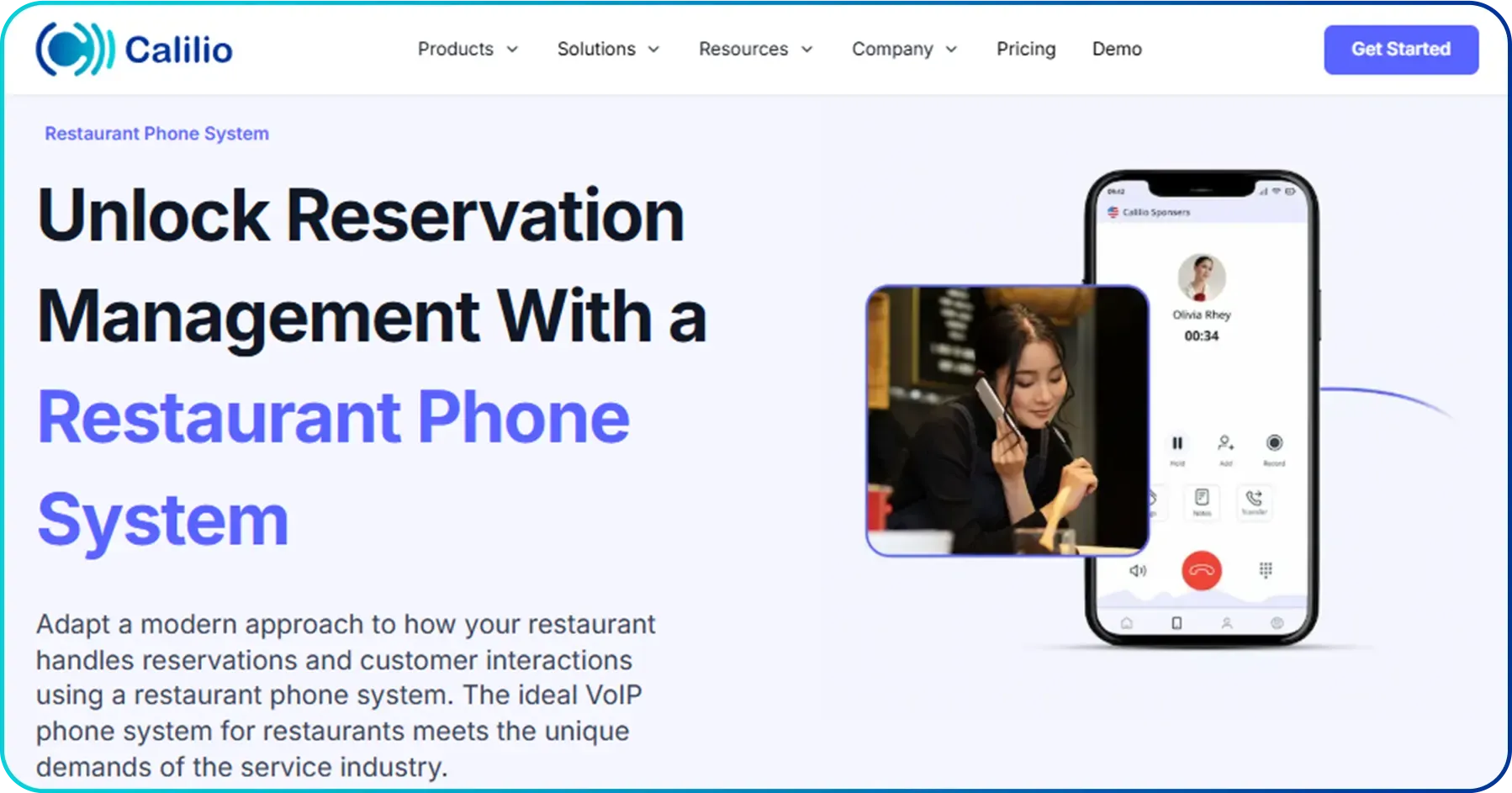 Agents can easily use call notes and tags to log orders, track statuses, and record special requests. Plus, AI-powered call reports with automated transcription turn conversations into text, helping staff review details, reduce errors, and save time.
Agents can easily use call notes and tags to log orders, track statuses, and record special requests. Plus, AI-powered call reports with automated transcription turn conversations into text, helping staff review details, reduce errors, and save time.
Key Features:
- Ring strategy
- IVR
- Call Queue and Queue Callback
- Greetings Voice Message
- Number Sharing
- Number Porting
- Call Notes/ Call Tags
- Multi-location support
Pricing:
Plan | Billed Monthly (per user) |
Basic Plan | $15 |
Business Plan | $35 |
Enterprise Plan | Custom |
2. Nextiva
Nextiva is a top-tier phone system and a reliable one for restaurants. It features an auto-attendant and call queues, along with an IVR, to help customers easily place orders, make reservations, or get information, even during peak hours without staff. As a result, it reduces wait time and missed orders.
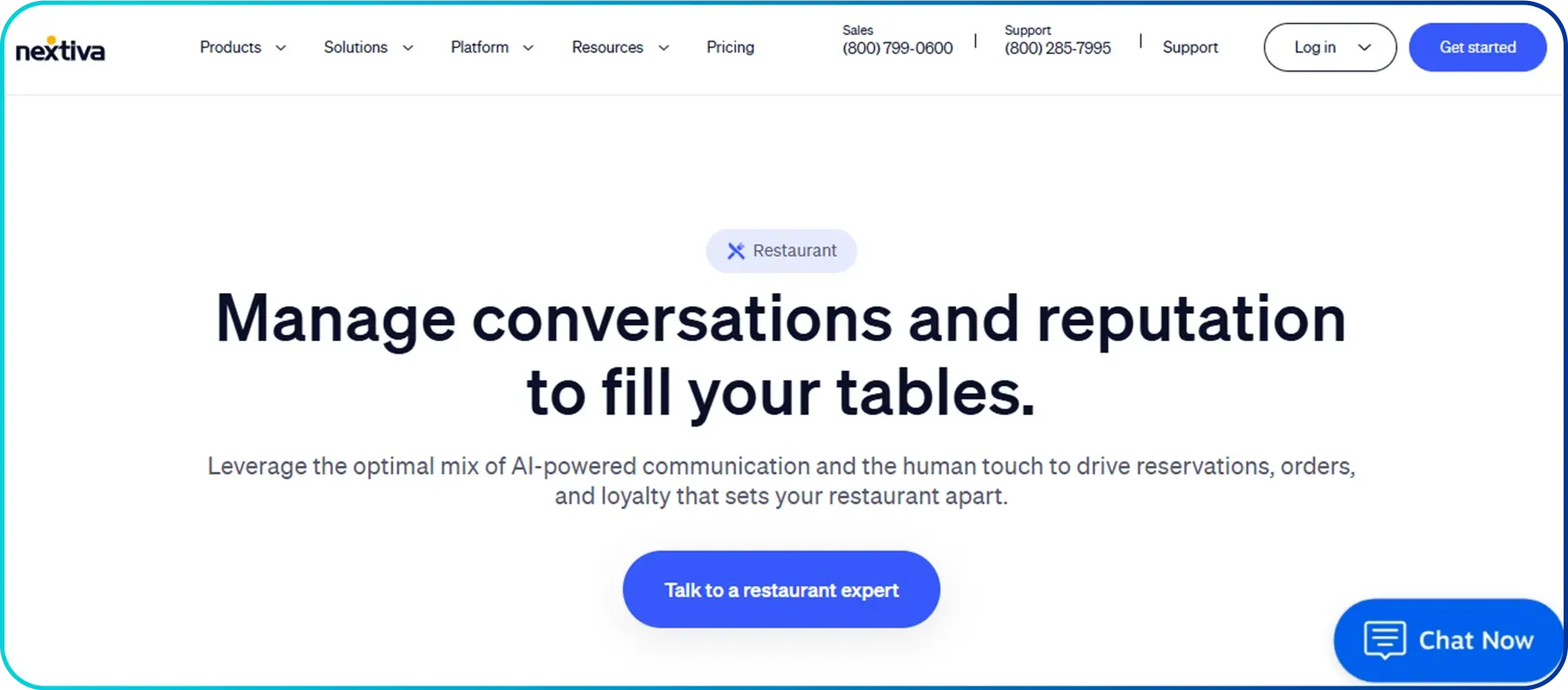
Additionally, Nextiva supports multi-channel communication, including voice, text messaging, and social media integration. It allows customers to connect through their preferred platforms.
Key Features:
- Unlimited calling
- Auto-attendant
- Call analytics
- Mobile and desktop apps
- Custom greetings
- Call park
- Call forwarding
Pricing:
Plan | Price (per user/month) |
Digital | $25 |
Core | $36 |
Engage | $50 |
Power Suite | $75 |
3. Ooma
Ooma restaurant telephone system offers a comprehensive suite of advanced features. It includes a virtual receptionist that automatically answers calls and shares key information like restaurant location, directions, and business hours, freeing staff to focus on in-person service.
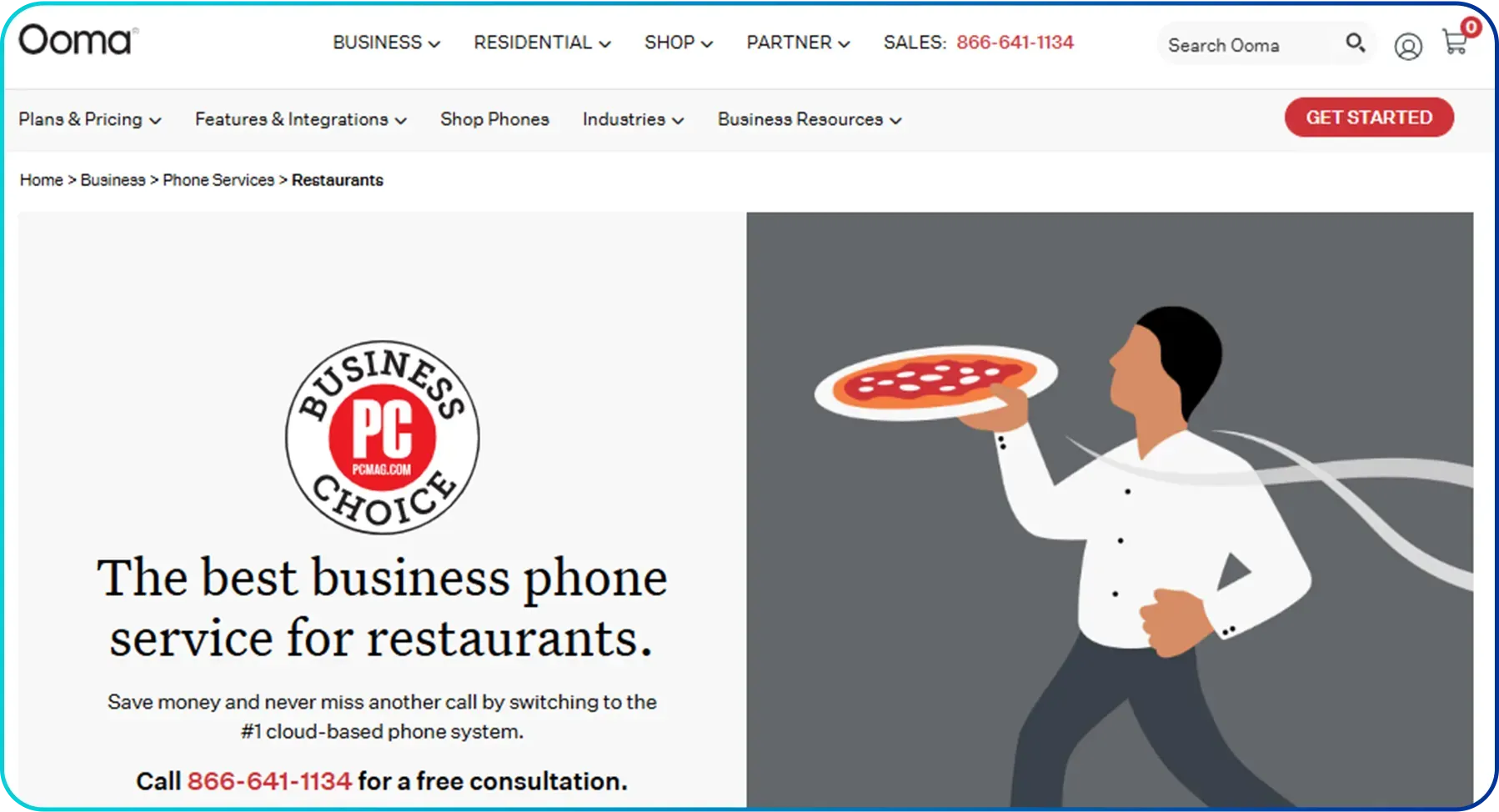 It also offers a hot-desking feature that lets employees share phones across multiple locations, making it ideal for franchised restaurants. It provides a square integration that combines phone system and payment processing into a single platform.
It also offers a hot-desking feature that lets employees share phones across multiple locations, making it ideal for franchised restaurants. It provides a square integration that combines phone system and payment processing into a single platform.
Key Features:
- Virtual receptionist
- Ring groups
- Call queuing
- Overhead paging
- Hot desking
- Call park
- Time-based call routing
- Voicemail transcription
- Enhanced call blocking
- Multi-ring/call flip
Pricing:
Plan | Price (per user/month) |
Essentials | $19.95 |
Pro | $24.95 |
Pro Plus | $29.95 |
4. RingCentral
RingCentral is a cloud-based phone system that offers unified communication for restaurants, including voice, video, messaging, and fax features, in a single interface. Even if you use another phone system, this platform lets you port your existing number for free.
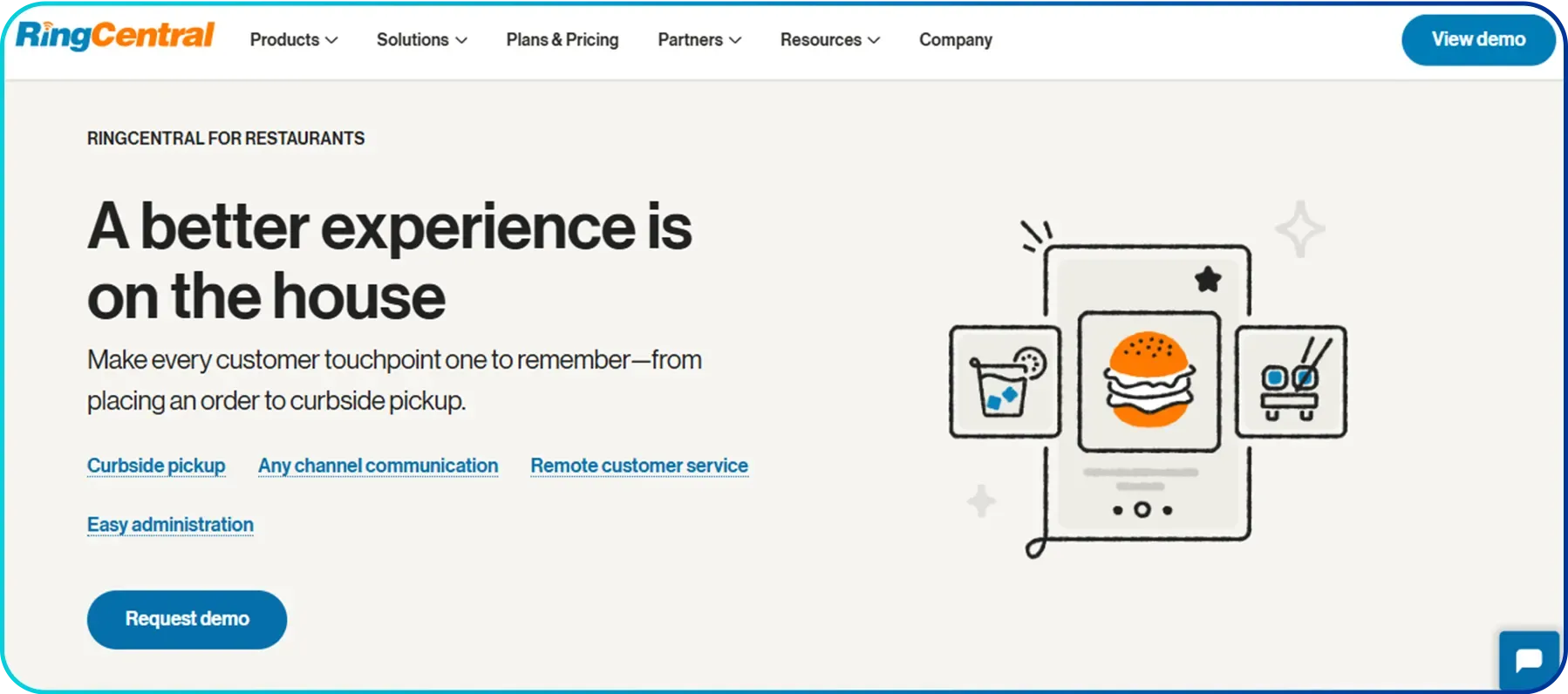 RingCentral also sends automated texts to customers for order updates, reservations, and promotions. Its multi-level IVR lets customers navigate menu options like reservations or takeouts, speeding up call handling and reducing unnecessary call transfers.
RingCentral also sends automated texts to customers for order updates, reservations, and promotions. Its multi-level IVR lets customers navigate menu options like reservations or takeouts, speeding up call handling and reducing unnecessary call transfers.
Key Features:
- Call forwarding
- Voicemail to email
- AI receptionist
- Multi-level IVR
- Multi-location support
- Team messaging
Pricing:
Plan | Price (per user/month) |
Core | $30 |
Advanced | $35 |
Ultra | $45 |
5. 3CX
3CX offers VoIP for restaurants to manage calls more efficiently with features like call routing, queuing, and forwarding. Its call management system makes sure that every call reaches the right person quickly, reducing wait times and missed calls, especially during busy hours. 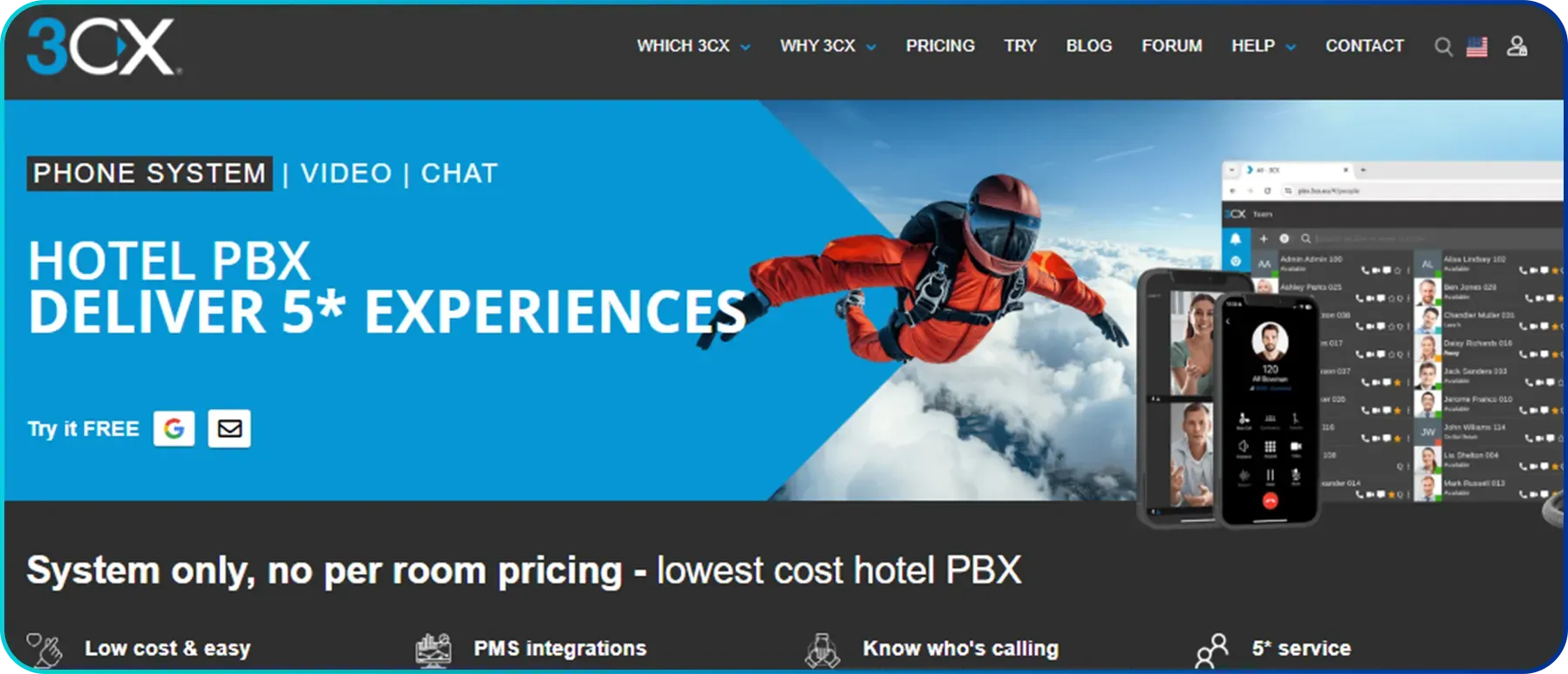 With its automated virtual receptionist (IVR), 3CX greets callers with custom messages and guides them to information like reservations or delivery options, freeing up staff time. It also integrates with popular CRM systems, allowing restaurants to log calls automatically, view customer history, and offer more personalized service.
With its automated virtual receptionist (IVR), 3CX greets callers with custom messages and guides them to information like reservations or delivery options, freeing up staff time. It also integrates with popular CRM systems, allowing restaurants to log calls automatically, view customer history, and offer more personalized service.
Key Features:
- Advanced Call Reporting
- Live Chat & Messaging Integration
- Centralized Contact Directory
- Video Conferencing
- Call Recording
- Voicemail Transcription
Pricing:
Plan | Price (per system/year) |
3CX PRO | $350 |
3CX ENT | $425 |
6. Talkroute
Talkroute is a modern VoIP phone system for businesses seeking efficient telephony solutions, including restaurants. It allows owners to customize the hours of operation and offers single and multi-level auto-attendant/IVR.
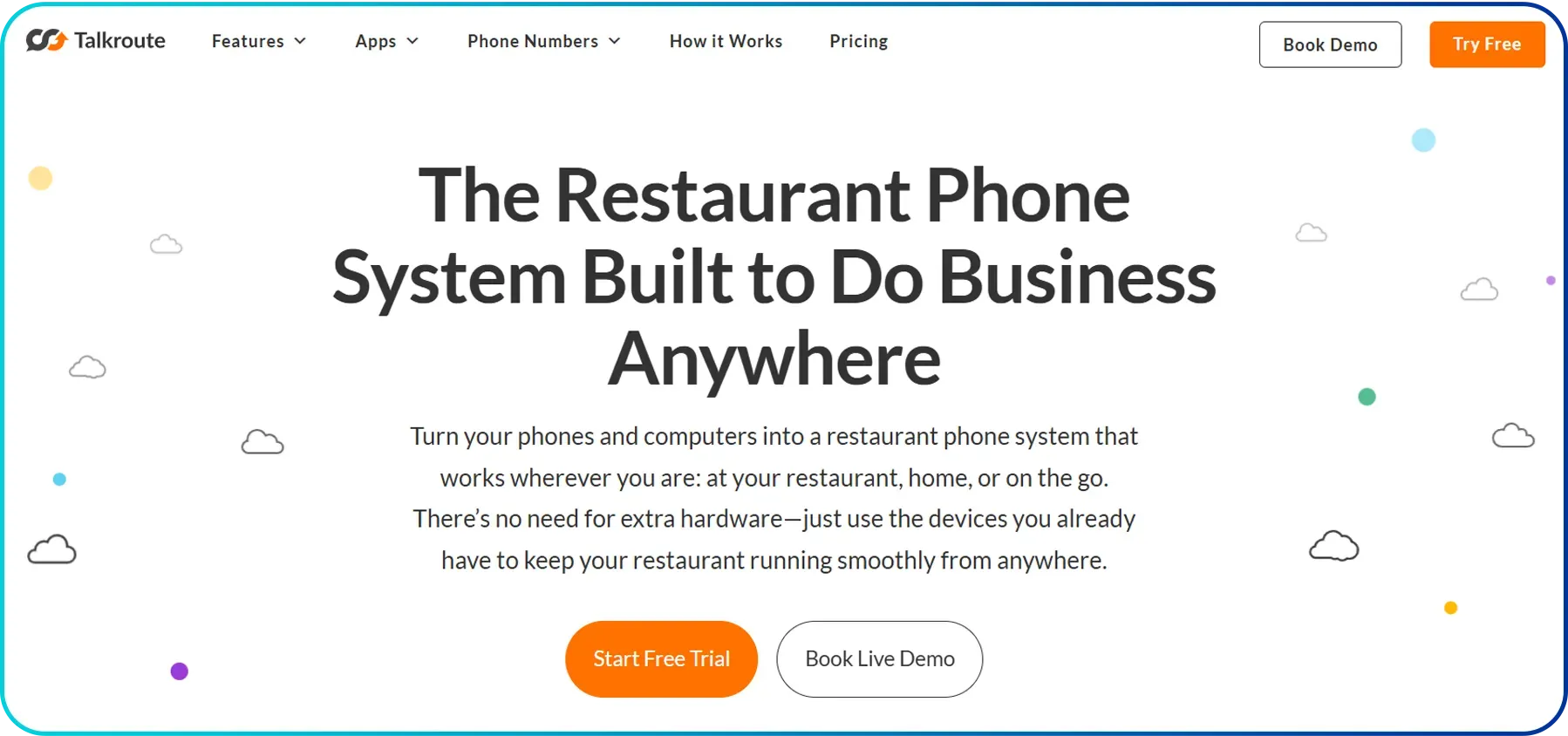 They can manage calls more efficiently by setting different behaviors for incoming calls during and outside operating hours. For example, calls can be automatically routed to voicemail, forwarded to another number, or directed to a custom auto-attendant with an “unavailable” message.
They can manage calls more efficiently by setting different behaviors for incoming calls during and outside operating hours. For example, calls can be automatically routed to voicemail, forwarded to another number, or directed to a custom auto-attendant with an “unavailable” message.
Key features:
- Call stacking
- Call recording
- Users & permissions
- Caller ID
- Menus and extensions
- Voicemail to email
- Custom Greetings
- Virtual receptionist
Pricing:
Plan | Price (per user/month) |
Basic | $19 |
Plus | $39 |
Pro | $59 |
Enterprise | Contact sales for exact pricing |
How to Choose the Best Restaurant Phone System?
Evaluate your restaurant’s needs, prioritize features like call management, check the integration capability with existing POS, consider reliability, and ensure the system is within budget.
1. Understand Your Restaurant’s Needs
Start by identifying how your restaurant uses the phone. For example, if you handle a lot of takeout or delivery orders, you'll need a system that supports high call volume and features like call queuing or auto-attendants.
2. Choose Between Landline, VoIP, or Cloud-Based Systems
Landlines are dependable but outdated. VoIP systems use the internet and are more flexible and cost-effective. Cloud-based systems are even more advanced, offering easy scalability and remote access, ideal for growing or multi-location restaurants.
3. Look for Key Features
Determine what features are essential and non-negotiable for your business. Make sure that you choose the system with features that align with your business needs.
4. Check Compatibility with Your POS and CRM
Choose a phone system that integrates with your existing point-of-sale and customer management software.
5. Evaluate Cost and Scalability
Look for a phone system that fits your current budget and allows growth. VoIP and cloud-based systems typically offer flexible pricing based on your needs, making them easy to scale.
6. Consider Support and Reliability
A phone system should be dependable, with strong customer support if issues arise. Choose a provider known for prompt technical assistance.
Conclusion
The right phone system for a restaurant can manage calls efficiently, reduce missed orders, and improve customer service. Modern VoIP systems like Calilio, Nextiva, Ooma, RingCentral, 3CX, and OpenPhone offer advanced features such as call routing, call queue, voicemail transcription, and system integration, ideal for busy restaurant environments.
Your Phone System Just Got Cheaper
Virtual numbers from just $2/month
Call rates starting as low as $0.016/min
The most cost-effective VoIP phone system for businesses
Powered by advanced AI telephony features
Compare low-cost business phone systems
Frequently Asked Questions
What is the best phone system for restaurants?
Calilio is one of the best phone systems for restaurants in 2025. It’s built to handle high call volumes, especially during peak hours, with features like advanced call management, call queuing, IVR, and number sharing. Calilio also includes tools like call notes, tags, and automated transcription, which help staff manage orders accurately and efficiently.
What do restaurants need in a phone system?

Still have questions?
Can’t find the answer you’re looking for? Please chat with our friendly team.
Stay in the loop
Get the latest call insights, trends, and updates delivered straight to your inbox.
By subscribing, you agree to receive updates from Calilio.
You can unsubscribe anytime.
Phone numbers
Get International Phone Numbers
Singapore
|Australia
|New Zealand